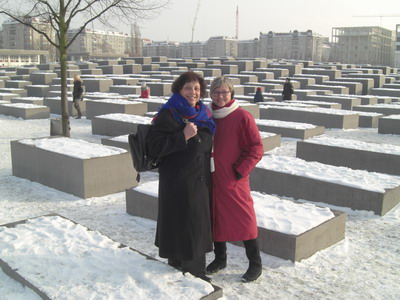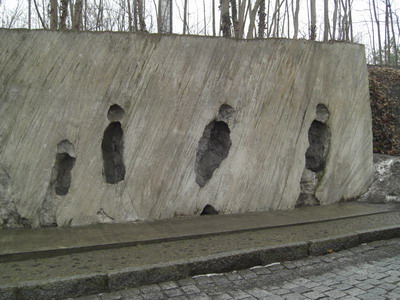VISIT
TO BERLIN
30
JANUARY - 6 FEBRUARY 2014
For two more pictures on This Week's Picture Archives, click here and here

Winter, with snow and days of extreme cold, is not the ideal time to
visit Berlin; but that is when Eitan attended the European Bridge
League Officers' Seminar. Our friend Ruthie Erez joined me and we
toured the city, with Eitan joining us for the Jewish sights after the
seminar.
Berlin is a huge city, about 15 times larger than Tel Aviv, with three
centres. Needless to say we did not manage to see all of the city nor
its amazing museums. Surprisingly, 6 days were not enough to see all
that Berlin has to offer. Our hotel was bounded by a canal on one side,
the snow-covered Tiergarten on the other with Potsdamplatz nearby by
way of Ben Gurionstrasse. Under Ben Gurion's leadership, Israel
recognised Germany in 1952, despite fervent opposition, thereby laying
the foundations for German reparations to Israel. Formal diplomatic
relations were only established in 1965, when the street was named.
Berlin's recent past is bracketed by the Holocaust and the Berlin Wall.
Here Ruthie and I stand in front of the massive memorial to the
murdered Jews of Europe, symbolized by over 2700 tomb-like structures
of different heights, set in row after endless row. When we arrived in
Berlin it was -6ºC and the stones were covered with snow.
The Berlin Wall, diividing the city into East and West Berlin from 1961
to 1990 was made from concrete blocks. Only a few parts
remain. To my bottom left is a picture of the Brandenburg Gate.
Originally built in 1671 as an entrance to the city surrounded by a
wall, that wall was demolished. When the city was divided in 1961 , the
Brandenburg remained in no-man's land until reunification.
Graffiti covered the western side of the Wall; the eastern side
remained blank as people were not allowed to approach the Wall, for
fear of their trying to escape..
Ruthie tried currywurst, a famous Berlin sausage. In the end, a
disappointing sausage smothered by ketchup with a sprinkling of curry
powder.

This is Checkpoint Charlie, one of the few places where people
could pass from East Germany to the West. The sign to the rightof the
road informs
people that they are leaving the American sector of Berlin. The western
part of the city was further divided into British and French enclaves.
The Berlin wall 155km long, effectively divided the city to prevent
escape from the communist regime. In 1963 my mother Gertie and I
visited Berlin.Unfortunately I have no memory of the Checkpoint, but
remember well the seemingly endless blocks of grey apartments around a
large circle. Everything seemed grey on that side of the city. Today I
can only wonder at the independent spirit of my mother to undertake
such an adventurous trip.
My other indelible memory of Berlin was of the Kaiser Wilhelm Memorial
Church. Bombed during WWII, inside the ruins was a statue of Jesus
covered in red paint, symbolising blood. There was much to mourn about
then. Germany had not yet publicly undertaken to mourn her German
Jewish citizens, but the Wall caused immensurable loss; loss of
freedoms, economic deprivations and the inability to move from place to
place.
The remains of the church are presently undergoing strengthening. The
staue of Jesus is still there, but clothed in its original pure white
marble, under a stunning mosaic of Kaiser Wilhelm and his bride
Augusta. (The Augusta Victoria Church on Mount Scopus was built by him.)

With our guide Lior from Gablinger Berlin Tours we visited Track 17
Memorial; at Grunewald. In Germany Jews had to wear the yellow Juden
Star, their identity cards were stamped with a "J" and in addition men
had to add "Israel" as their middle name while women had to add
"Sarah." Ghettos were not established in Germany itself. Until 1941
Jews were forcibly encouraged to emigrate by loss of citizenship and
jobs, by boycotts, pogroms and severe restrictions on all forms of
their lives. More than 50,000 of Berlin's 160,000 Jews did
emigrate.
Starting in October 1941 (after the invasion into Russia)
emigration was no longer an option. People were told that they could
take two suitcases of 50 kilo each and had to walk over 10 km to
Grunewald Track 17. Only the severely disabled were transported by
trucks. Track 17 today has trees growing on the tracks on either side
of the station siding, so that no train can ever leave the station.
Alongside the platform are metal plaques, marking the date, number of
Jews deported, the name Berlin and the destination.We couldn't help
noticing that the first transports mainly to Riga but also to Lodz were
either 50 or 100 in number. Lior told us that there were 50 seats to a
carriage. The Jews had to buy a ticket for their deportation. If they
didn't have enough money their houses were confiscated in lieu of
tickets!
The Gestapo paid the railways who made a fortune from
forced transport of Jews. In 1943 the numbers on the transport
increased dramatically when Jews were rounded up in the factories where
they worked and taken directly to Track 17. Most were taken to
Thereseinstadt and from there to Auschwitz.
The Deutsche Bahn Railway, even after reunification, had great
dificulty in even mentioning its role in the deportation of Jew. The
memorial, erected in 1998, consists of 186 plaques of which three are
blank as details are not known. Horrfyingly, the last tranport took
place on 27 March 1945, a week before the end of the war; deportation
and
destruction of Jews remained a high priority even when Germany was
clearly losing the war.
This difficulty in recognising responsibilty is further reflected by
the three memorials erected on the way to Track 17. The first
memorial was erected by private citizens in October 1987. It consists
of three railway sleepers with a simple dedication to "the People who
were deported." Note that there is no mention that they were
Jewish. The small stone columns are a later addition. On the way
to Track 17 is the third memorial, from 1991, which has a concrete wall
with parts missing, symbolizing the deported Jews. The plaque here
specifically mentions Berlins' Jews deported and murdered.
The Block of Women Memorial honours the 600 women and children who
protested here opposite the Jewish Welfare Administration building in
February 1943. Until then Mischlinge (mixed) marriages were tolerated
and the
Jewish spouses of Aryans were not deported. As part of the Factory
Aktion of February 1943 some 2,000 Jews, mostly men, were
detained together with about another 6,000 Jews destined for
deportation. After a week of peaceful demonstration, the spouses were
released with the understanding that they would replace some of the
Jews rounded up in the Factory Aktion.
The six-part memorial erected in 1991 was designed by Ingeborg
Hunzinger, and is on the site of the Old Berlin Synagogue.

We were
enthralled by a visit to the Brush and Broom Factory of Otto Weidt.
Otto, a pacifist was partially blind. He had a factory in
Rosenthallerstrasse
where he protected some 30 visually impaired and deaf Jews.by
employing them. He bought food on the black market to supplement his
workers' meagre rations. Together with a circle of helpers he bribed
Gestapo officials, forged documents, and hid a family in his workshop
(in a tiny room hidden behind the cupboard in the picture.).
When he could no longer protect his employees, he arranged for them to
be transported to Thereseinstadt, which was mistakenly considered to be
a 'better' concentration camp. He sent over 150 food parcels there. He
managed to rescue Inge Deutschkorn, an amazing woman of 93 who still
works at the Weidt Memorial.
When he heard that Alice Licht, who had worked in his office, was
transferred from Thereseinstadt to Auschwitz, he travelled by train to
Auschwitz, only to find that she has been taken to Christianstadt. He
took a train there and rented an apartment where he left money and
clothes. By bribing a Pole he was able to inform Alice about the
arrangments. About to be taken on the Forced March, she managed to
escape, find the apartment and eventually leave Germany.
Both Otto Weidt and his wife Elsie, togeher with other brave Germans
involved in rescue were recognised as Righteous Among the Nations at
Yad Vashem.
Because the Berlin wall cut through Berlin eratically, it is not always
possible to know if one is on the East or West side of Berlin. But
reminders of the Holocaust are today everywhere. Embedded in the
pavement are brass squares, remembering the names of the Jews
evicted from their houses at or near that location..
The New Synagogue of Berlin was inaugurated in 1866 in the presence of
Otto von Bismark, who unified Prussia and Brandenburg into Germany.
Bismark allowed the building to be as tall as the Jewish community
wanted as long as it was lower than the Church. On Kristallnacht, when
the synagogue was set afire Otto Bellgardt a policeman, claimed that it
was a protected historical landmark that he was prepared to protect by
gunfire if necessary. He then called the fire brigade, thus saving the
synagogue. It was later damaged during the bombing of Berlin and only
partially rebuilt.
A grand Moorish structure, it reflects the elevated status of German's
Jews in the 19th Century.
On our last day in Berlin we took the train to Potsdam where we visited
various imposing palaces of Frederick Great and Frederick IV. Click here for "This Week's Picture"
of Eitan, Ruthie and I taken in front of San Soucci
the 'modest' private palace of Frederick the Great. We
could only imagine how the gardens looked in summer with the terraces
blanketed by the greens of grape vines and fig trees. Potsdam is a
delightful small town and deserved more time than we had
available.
Our last stop was at the nearby Wannsee Palace. On 20 January 1942
Reinhard Heydrich convened senior Nazi officials at Wannsee to
discuss the implementation of the Final Solution of the Jews, moving
from mass murder to planned genocide. The whole
meeting lasted for 90 minutes, including drinks and cigars
afterwards. Heydrich was to be in overall charge of
implementation. Adolph Eichman was present and conducted the
proceedings. Today we know that the decision to eliminate the Jews from
the face of the earth had been previously decided upon by a higher
echelon (Hitler), although there is no written record of this. Only one
copy of the Wannsee Protocol was found, the rest were destroyed..
And so the fate of one third of the Jewish people was sealed
while the world looked on.

